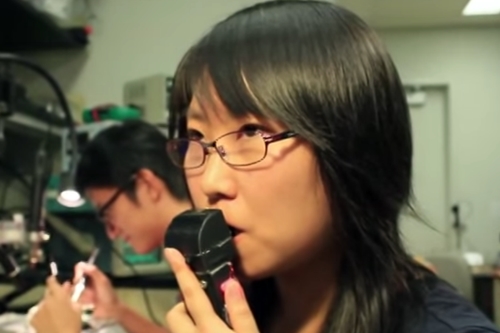24 August 2015. Biomedical engineers at Johns Hopkins University in Baltimore developed a portable device that quickly returns a person’s vital health indicators in an ambulance, at an outpatient clinic, or even at home. Test results of the device, called MouthLab, led by biomedical engineering and of otolaryngology professor Gene Fridman, appear in the September issue of the journal Annals of Biomedical Engineering (paid subscription required).
Fridman is also founder of Multisensor Diagnostics LLC, a company in Baltimore with an option to license the MouthLab technology from Johns Hopkins. The university first applied for a patent on the MouthLab technology in 2011, with a second patent application in 2014. MouthLab is one of the Maryland Innovation Initiative projects funded by Maryland Technology Development Corporation that supports research with commercial potential from university labs in the state.
The Johns Hopkins team is seeking a fast and easy, yet still accurate method to test for an individual’s general health conditions, rather than the complex and expensive all-in-one vital signs monitors used today. These devices, while effective in capturing vital signs, require attaching individual sensors by trained clinicians, in a hospital or similar environment.
Fridman and colleagues designed MouthLab for individuals, emergency medical technicians, and outpatient staff to test for vital signs. The MouthLab device, now in prototype stage, is designed to capture pulse and breathing rate, temperature, blood oxygen saturation, and blood pressure. In addition, the device has three electrodes to measure electrical activity of the heart like an electrocardiogram or ECG.
The MouthLab unit is about the size of a landline telephone handset. It has a replaceable mouthpiece with sensors to measure temperature and blood volume, and other sensors measuring breathing through the nose and mouth. The hand-held device has a thumb pad with a miniature pulse oximeter that uses light beams to measure oxygen levels in the blood. ECG measurements are made with electrodes on the thumb pad and in the mouthpiece that touches the upper and lower lips.
Measuring blood pressure presented a challenge to the designers, who wanted to avoid attaching a conventional arm-squeezing cuff. The battery-powered MouthLab instead uses the ECG signal to determine if the heart is contracting, and then measures blood volume through sensors in the thumb and upper lip. Software written for the device uses those data to calculate systolic and diastolic pressure readings, top and bottom blood pressure numbers.
Fridman says the MouthLab prototypes were made with parts fabricated on a three-dimensional printer. The prototype now sends its measurements via Wi-FI signals to a nearby laptop where readings are displayed on a screen. MouthLab devices are eventually expected to display readings on the device itself.
In the journal article, researchers tested the MouthLab prototype with 52 volunteers, who also took part in traditional hospital-style vital signs readings. The results show MouthLab returned results comparable to the vital signs produced by hospital equipment.
In a university statement, Fridman calls the device “a ‘check-engine’ light for humans.” He expects future versions of MouthLab to to measure chemical signals in blood and saliva, as well as breath, to check for a number of a number of acute and chronic conditions. “We envision the detection of a wide range of disorders,” says Fridman, “from blood glucose levels for diabetics, to kidney failure, to oral, lung and breast cancers.”
Fridman tells more about MouthLab in the following company video.
- University Faculty Design Mood-Tracking Mobile App
- Cough Diagnostics Mobile App in Clinical Trial
- Alliance to Collect Mobile Health Data for Clinical Trials
- Point-of-Care Ebola Test Found Accurate in Field Test
- Smartphone Vision App Found Accurate as Clinic Test
* * *


 RSS - Posts
RSS - Posts
[…] All-Purpose Hand-Held Device Checks for Vital Signs […]